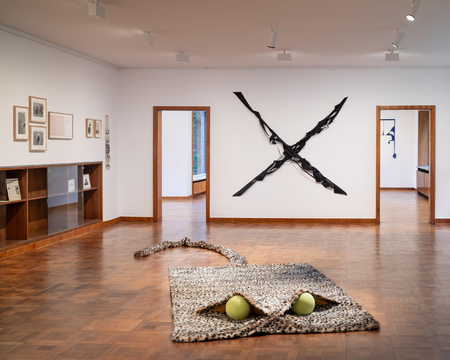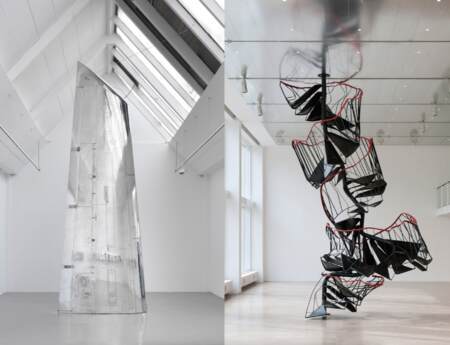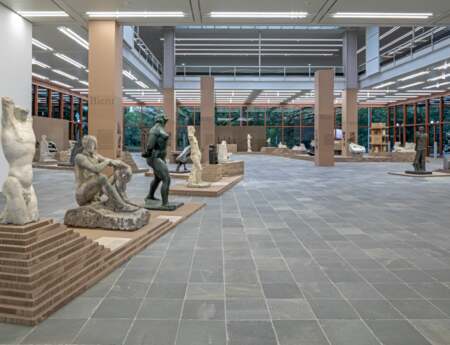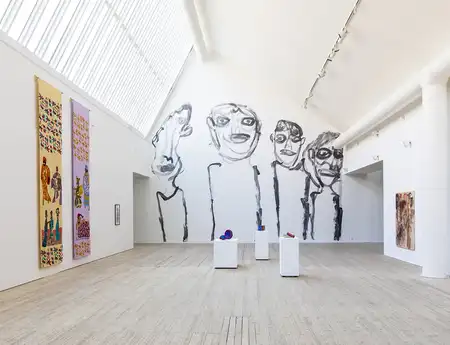Museen Haus Lange & Haus Esters
Wilhelmshofallee 91-97
47800 Krefeld
Germany
Marion Baruch: Social Fabric Anna K.E.: For Our Parents
The Kunstmuseen Krefeld are giving Anna K.E. and Marion Baruch their first solo museum exhibitions in Germany.
“With Marion Baruch and Anna K.E. we bring together two outstanding female positions from different generations under the common theme The Human Scale as part of our exhibition series HLHE Dialogue. For both artists, the body is an instrument of measurement and a benchmark for the perception of space, movement, and interaction,” says museum director Katia Baudin. “Since 2017 the Kunstmuseen Krefeld have been showcasing in the HLHE Dialogue series the interplay of historical and more recent or contemporary positions in art, design, and architecture in Haus Lange and Haus Esters, thus reflecting on the legacy of modernism in ever new ways”.
With the exhibition Marion Baruch: Social Fabric, the Kunstmuseen Krefeld present the work of an artist who has only begun to receive long-overdue recognition in recent years. Marion Baruch’s (b. 1929 in Timișoara, Romania) multilayered artistic work engages with subjects such as feminism, the critique of consumption, and migration. Her material ranges from textiles and photography to design objects and more. In Haus Lange, constructed by Ludwig Mies van der Rohe in the late 1920’s as a residence for silk manufacturer Hermann Lange, the Kunstmuseen Krefeld show around sixty artworks from five decades of the ninety-five-year-old artist. The retrospective begins with the conceptual and performative objects of the late 1960s, shows design as well as sculptural and conceptual works of the 1980s and ‘90s, and presents a large selection of the more recent installation-based works made from offcuts of the ready-to-wear fashion industry for which Baruch has become internationally known in recent years. Baruch worked with designers to create whimsical furnishings and in 1991, she founded the company NAME DIFFUSION, turning her own existence as an artist into a business model and staging showrooms for the presentation of textile products. The core of her work remains the textile with its diverse levels of meaning—connection and communication, body and identity, the mechanisms of the clothing industry. Since 2012, she has been producing works using offcuts from Milan’s fashion industry.
In parallel, the NAK (Neuer Aachener Kunstverein) presents the solo exhibition Marion Baruch: Widerstandsgeist (until November 24).
With New York-based artist Anna K.E. (b. 1986, Tbilisi, Georgia) the Kunstmuseen Krefeld present an artist who works in a variety of media and genres, including painting, sculpture, installation, performance, drawing, language, and film. She combines architecture, design, and art effortlessly and with relish. Through precise staging, Anna K.E. shifts the viewer’s perception of Mies van der Rohe’s Haus Esters. For the exhibition Anna K.E.: For Our Parents, she intersperses the rooms with a system of references, linguistic allusions, and fragile architectural components. Approximately twenty works from the past two years are on view, including a new series of enamel pieces and a wall drawing. Inspired by the special character of the houses, the artist has also made a new film and developed a site-specific outdoor installation.
Anna K.E. interprets Haus Esters as a place where conventional notions of space and time are playfully suspended. Colorful arrows on the floor signal: This is the way. Their auspicious coloring is the result of various plant seeds and cat litter. Narrow sections of walls, usually neglected in exhibitions, are marked with enamel arrows. The system of clues and references allows an unusual, sometimes bizarre perception of the spaces. The experiment of spatial displacement and alienation continues in an architectural landscape that runs like a narrow band through several rooms. This utopian city model is ultimately a test of materials. Countless magnets and various metal elements form a fragile construction held together only by the invisible magnetic field. Placed on thin metal legs, this pseudo-architecture appears to float and at the same time forms a massive barrier that regulates the tour through the rooms.
Director: Katia Baudin
Curators: Dr. Magdalena Holzhey, Dr. Sylvia Martin



